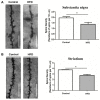Impact of Pharmacological and Non-Pharmacological Modulators on Dendritic Spines Structure and Functions in Brain
- PMID: 34943913
- PMCID: PMC8699406
- DOI: 10.3390/cells10123405
Impact of Pharmacological and Non-Pharmacological Modulators on Dendritic Spines Structure and Functions in Brain
Abstract
Dendritic spines are small, thin, hair-like protrusions found on the dendritic processes of neurons. They serve as independent compartments providing large amplitudes of Ca2+ signals to achieve synaptic plasticity, provide sites for newer synapses, facilitate learning and memory. One of the common and severe complication of neurodegenerative disease is cognitive impairment, which is said to be closely associated with spine pathologies viz., decreased in spine density, spine length, spine volume, spine size etc. Many treatments targeting neurological diseases have shown to improve the spine structure and distribution. However, concise data on the various modulators of dendritic spines are imperative and a need of the hour. Hence, in this review we made an attempt to consolidate the effects of various pharmacological (cholinergic, glutamatergic, GABAergic, serotonergic, adrenergic, and dopaminergic agents) and non-pharmacological modulators (dietary interventions, enriched environment, yoga and meditation) on dendritic spines structure and functions. These data suggest that both the pharmacological and non-pharmacological modulators produced significant improvement in dendritic spine structure and functions and in turn reversing the pathologies underlying neurodegeneration. Intriguingly, the non-pharmacological approaches have shown to improve intellectual performances both in preclinical and clinical platforms, but still more technology-based evidence needs to be studied. Thus, we conclude that a combination of pharmacological and non-pharmacological intervention may restore cognitive performance synergistically via improving dendritic spine number and functions in various neurological disorders.
Keywords: dendritic spines; diet; enriched environment; modulators; pharmacological modulators; yoga and meditation.
Conflict of interest statement
The authors declare no conflict of interest.
Figures



Similar articles
-
Plasticity of dendritic spines: Molecular function and dysfunction in neurodevelopmental disorders.Psychiatry Clin Neurosci. 2019 Sep;73(9):541-550. doi: 10.1111/pcn.12899. Epub 2019 Jul 8. Psychiatry Clin Neurosci. 2019. PMID: 31215705 Review.
-
βIII Spectrin Is Necessary for Formation of the Constricted Neck of Dendritic Spines and Regulation of Synaptic Activity in Neurons.J Neurosci. 2017 Jul 5;37(27):6442-6459. doi: 10.1523/JNEUROSCI.3520-16.2017. Epub 2017 Jun 2. J Neurosci. 2017. PMID: 28576936 Free PMC article.
-
Dendritic spines: Revisiting the physiological role.Prog Neuropsychopharmacol Biol Psychiatry. 2019 Jun 8;92:161-193. doi: 10.1016/j.pnpbp.2019.01.005. Epub 2019 Jan 15. Prog Neuropsychopharmacol Biol Psychiatry. 2019. PMID: 30654089 Review.
-
Synapses and dendritic spines as pathogenic targets in Alzheimer's disease.Neural Plast. 2012;2012:247150. doi: 10.1155/2012/247150. Epub 2012 Feb 6. Neural Plast. 2012. PMID: 22474602 Free PMC article. Review.
-
Benzothiazole Amphiphiles Promote the Formation of Dendritic Spines in Primary Hippocampal Neurons.J Biol Chem. 2016 Jun 3;291(23):11981-92. doi: 10.1074/jbc.M115.701482. Epub 2016 Mar 28. J Biol Chem. 2016. PMID: 27022020 Free PMC article.
Cited by
-
Physical Exercise Exerts Neuroprotective Effect on Memory Impairment by Mitigate the Decline of Striatum Catecholamine and Spine Density in a Vascular Dementia Rat Model.Am J Alzheimers Dis Other Demen. 2022 Jan-Dec;37:15333175221144367. doi: 10.1177/15333175221144367. Am J Alzheimers Dis Other Demen. 2022. PMID: 36515911 Free PMC article.
-
Post-Synapses in the Brain: Role of Dendritic and Spine Structures.Biomedicines. 2022 Aug 2;10(8):1859. doi: 10.3390/biomedicines10081859. Biomedicines. 2022. PMID: 36009405 Free PMC article. Review.
-
From Synaptic Plasticity to Neurodegeneration: BDNF as a Transformative Target in Medicine.Int J Mol Sci. 2025 Apr 30;26(9):4271. doi: 10.3390/ijms26094271. Int J Mol Sci. 2025. PMID: 40362507 Free PMC article. Review.
-
Discussion on the Application of Mindfulness Therapy in the Treatment of Diabetic Peripheral Neuropathy: A Narrative Review.Psychol Res Behav Manag. 2025 Aug 12;18:1729-1747. doi: 10.2147/PRBM.S533200. eCollection 2025. Psychol Res Behav Manag. 2025. PMID: 40831882 Free PMC article. Review.
-
Molecular insights into enriched environments and behavioral improvements in autism: a systematic review and meta-analysis.Front Psychiatry. 2024 Feb 1;15:1328240. doi: 10.3389/fpsyt.2024.1328240. eCollection 2024. Front Psychiatry. 2024. PMID: 38362032 Free PMC article.
References
-
- McGuier N.S., Uys J.D., Mulholland P.J. Chapter 9—Neural morphology and addiction. In: Torregrossa M., editor. Neural Mechanisms of Addiction. Academic Press; Cambridge, MA, USA: 2019. pp. 123–135.
Publication types
MeSH terms
Substances
LinkOut - more resources
Full Text Sources
Medical
Miscellaneous

